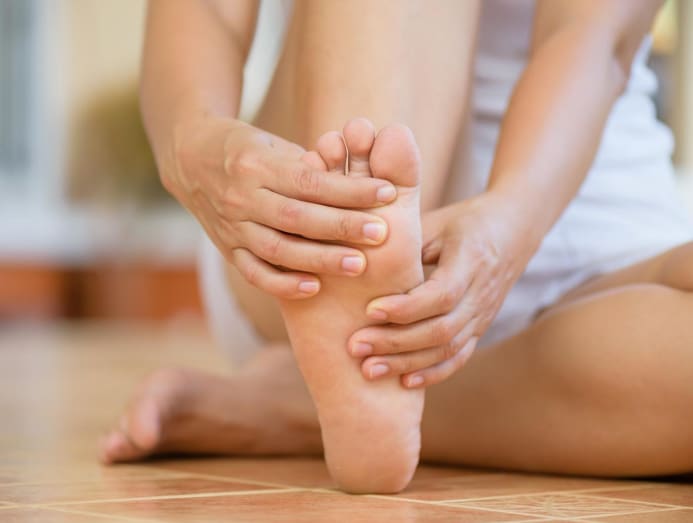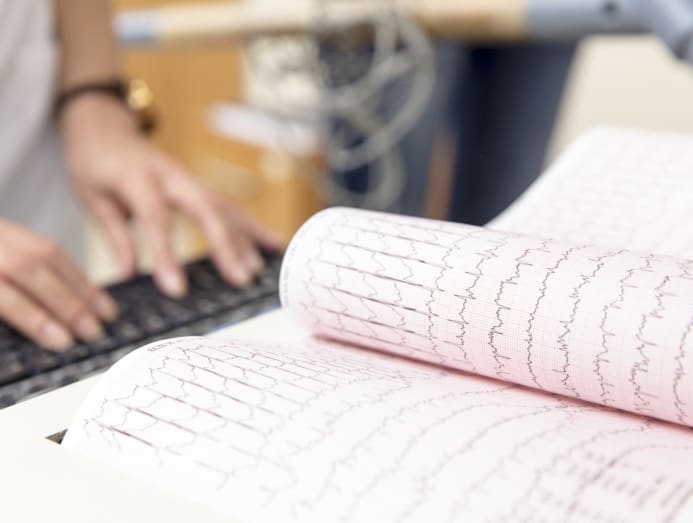Anxiety gave her a fake heart attack: Panic attacks have similar symptoms, may be caused by perimenopause
A freak accident ended with one woman’s visit to the emergency department with a suspected heart attack. It turned out to be a panic attack, possibly related to perimenopause. Find out the differences between panic and heart attacks and how perimenopause could be a factor.

Chest pains and breathlessness can be symptoms of a panic attack, heart attack or even perimenopause. (Photo: iStock/jittawit.21)
When Emma’s (not her real name) new iPhone 14 tumbled out of her hand, she instinctively stretched out a foot to cushion its fall. It smashed squarely onto the tender flesh between the joints of her big toe.
The civil servant, who’s in her 40s, had no way of knowing that this single incident would set off a chain of events that would take her to the emergency department – and lead doctors to suspect she was having a heart attack.
After the accident, she iced her toe and kept her weight off it. She thought nothing more of it, but by the third day, it had swelled up like a purple mushroom.
The polyclinic near her office had podiatry and X-ray departments and she managed to book an appointment with a podiatrist later in the day. But she later got a call from the appointments hotline saying she needed to see a doctor first, in order to get a referral to see the podiatrist.
As luck would have it, all the doctors were fully booked. By then, Emma’s toe was throbbing in pain. The officer suggested she walk in anyway and explain her situation.

After she arrived, it took almost two hours before a doctor could see her. Stressed out by the situation and pain, Emma was already feeling light-headed and tight in the chest but dismissed it.
The doctor suspected a toe fracture, which could only be confirmed with an X-ray. By that time, however, both the X-ray and podiatry departments had closed for the day. He suggested that Emma could get quicker medical attention at a hospital’s Accident & Emergency (A&E) department.
“I FELT LIKE I WAS HAVING AN OUT-OF-BODY EXPERIENCE”
After more waiting at the hospital, Emma was examined at the A&E. The nurse noticed that Emma was sweating despite it being a cool evening, and feeling breathless on top of the continuing chest tightness.
Has she ever felt these symptoms before, the nurse asked. Emma recalled that a week ago, she suffered sudden pain and some numbness in her chest.
As she had sought medical help for similar symptoms two years ago and was given a clean bill of health, Emma simply rested until the pain went away.

Hearing this, the nurse hurried Emma into a consultation room. Hobbling in pain, she reminded the nurse that she couldn’t walk fast. “The nurse looked at me very seriously and said, ‘Ma’am, you need to hurry. You might be having a heart attack.’
“I was stunned. I even protested that I was there for my toe!” recalled Emma.
The nurse was in such a rush, she pulled Emma’s clothes and bra up without removing them and stuck on electrode pads for an electrocardiogram (ECG).
Emma lay there in a daze, confused. “As I watched her running about, I felt like I was having an out-of-body experience. A sense of dread hit me … Am I really having a heart attack now?” she wondered frantically.
The ECG turned out normal but Emma still had to do blood tests, get her toe – and now her chest – X-rayed, and be kept for observation.
Thankfully, the tests showed no heart attack – and her toe was not broken.
The diagnosis for the chest pains and breathlessness: A possible panic attack due to anxiety. She was referred to a cardiologist for a follow-up.
Emma figured that the panic attack was caused by the string of stressful situations while waiting to get medical help and having to explain her situation to medical staff over and over again.
HEART ATTACK VS PANIC ATTACK: HOW TO TELL THE DIFFERENCE
Dr Derek Yong, a Senior Consultant, and Clinical and Interventional Cardiologist, at Restore and Prime Heart Centres, shared some similarities and differences between the two.
Heart attack symptoms:
- Rather than pain, you could feel diffused chest discomfort, which spreads out instead of being localised in one spot. This is typically gradual in onset.
- Provoked by exertion
- The pain radiates to an upper extremity, like your arms
- Associated with cold sweats
- Nausea and vomiting
Panic attack symptoms:
Typically presents with spontaneous, discrete episodes of intense fear that begin abruptly and last for several minutes to an hour. It may include these symptoms:
- Palpitations
- Sweating
- Trembling or shaking
- Sensations of shortness of breath or being smothered
- Feelings of choking
- Chest pain or discomfort
- Nausea or abdominal distress
- Feeling dizzy
- Chills or heat sensations
- Numbness or tingling sensations
- Derealisation (feelings of unreality) or depersonalisation (being detached from oneself)
- Fear of losing control or “going crazy”
- Fear of dying
However, Dr Yong cautioned that it may be difficult for the layman to differentiate a panic attack from a heart attack. “It requires an electrocardiograph and usually a series of blood tests to confidently exclude heart attack. If the above symptoms occur, it is advisable to seek immediate medical attention.”
SO IT’S A PANIC ATTACK – BUT DON’T LET YOUR GUARD DOWN
In hindsight and armed with a list of symptoms, Emma now realises that she was having a panic attack. However, she still attended her appointment with a cardiologist faithfully, which Dr Yong said is important. “This will exclude serious medical conditions, especially cardiorespiratory related ones.”
These include chronic obstructive pulmonary disease (COPD), asthma, bronchitis, emphysema, hypertension, angina, respiratory infections like pneumonia, among others.
Don’t make the mistake of thinking it’s just a panic attack. “Individuals with panic disorder appear to have a greater risk of coronary artery disease than individuals without panic disorder,” warned Dr Yong.
Interestingly, he said that globally, there is a higher reported frequency in females presenting with panic attacks/disorders, with a lifetime prevalence of 5 per cent in females versus 2 per cent in males.
Related:
OR … IT COULD BE PERIMENOPAUSE
Although Emma’s panic attack was likely induced by the pain and anxiety she felt while waiting to be treated at the polyclinic, compounded by work and relationship stress, there could be another reason – perimenopause.
She recounted how a friend too, once visited the A&E because her symptoms suggested a heart attack. The doctor eventually diagnosed it as hormonal issues and said it was common among women in their 40s.
They know of at least two other women in the same age group who suffered similar symptoms, later diagnosed as perimenopause.
Perimenopause – the period where a woman’s body is transitioning to menopause – can start as early as in your mid-30s, according to information from the Cleveland Clinic website. It lasts for up to four years before you finally hit the Big M, defined as going more than 12 months without a period.

Research has shown that other than the usual menopausal symptoms like irregular periods and hot flashes, some perimenopausal women also experience panic attacks due to hormonal changes. In more severe cases, it may lead to depression.
In a news article about menopause and depression in women published on the Johns Hopkins Medicine website, Dr Jennifer Payne, a psychiatrist and director of the Women's Mood Disorders Center at Johns Hopkins University, explained that “when women go through sudden hormonal changes like those that come with perimenopause, puberty, postpartum and even their monthly cycle, they’re at a higher risk for depression”.
This is particularly true for those who already suffer from postpartum depression or have always had significant mood changes before their period. Women are also twice as likely as men to experience depression.
However, even those without a previous history are not immune to anxiety or depression. A 10-year study of 2,956 American women across multiple races and ethnicities found that women with low anxiety pre-menopausally may actually be more susceptible to high anxiety during and after the menopausal transition than before. Pre-menopause is the time between a woman’s first period and the onset of perimenopause.
In comparison, women with a previously diagnosed condition may already be chronically anxious and were not at increased risk.
According to the Harvard Study of Moods and Cycles, women with no history of depression were also nearly twice as likely to experience depression in the menopause transition, compared with pre-menopausal women.
WHEN IN DOUBT, SEEK MEDICAL HELP
Laymen like us simply cannot tell if it’s a panic attack, heart attack or perimenopause. Even an experienced cardiologist like Dr Yong said: “Although I may suspect that it’s a panic attack on clinical grounds, I still have to rely on tests to differentiate it from a heart attack.”

Emma’s follow-up with a cardiologist included an Exercise Myocardial Perfusion Scan. It involved an ECG Stress Test on a treadmill to assess her heart’s response to increased workload and demand for blood during exercise; and Maximum Intensity Projection (MIP) images to check for changes in the heart.
The exercise session took about an hour and the whole procedure took almost four hours, including waiting time at the government hospital.
Fortunately, she cleared all tests. “I paid about S$450 after subsidy at the government hospital and could pay part of it with my Medisave. A small sum, compared with the peace of mind of confirming I don’t have heart disease.
“It was always nagging at the back of my mind because this was not my first episode of chest pain,” said Emma. “Health screenings may cost but always get your symptoms checked before it’s too late. Never leave your health to chance.”
CNA Women is a section on CNA Lifestyle that seeks to inform, empower and inspire the modern woman. If you have women-related news, issues and ideas to share with us, email CNAWomen [at] mediacorp.com.sg (CNAWomen[at]mediacorp[dot]com[dot]sg).










